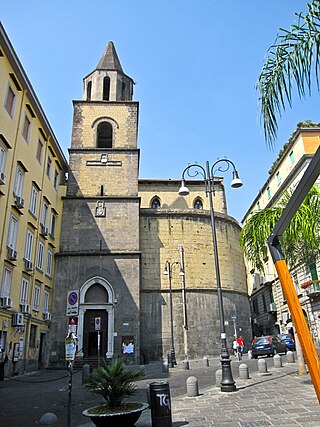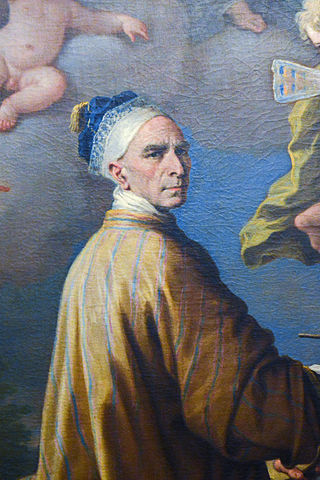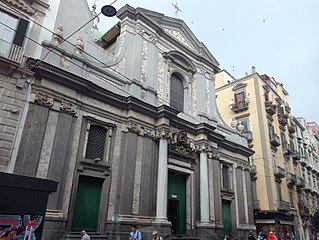
Piazza del Plebiscito is a large public square in central Naples, Italy.

San Francesco a Ripa is a church in Rome, Italy. It is dedicated to Francis of Assisi who once stayed at the adjacent convent. The term Ripa refers to the nearby riverbank of the Tiber.

Gesù Nuovo is the name of a church and a square in Naples, Italy. It is located just outside the western boundary of the historic center of the city. To the southeast of the spire, one can see a block away the Fountain of Monteoliveto and the piazza of the church of Sant'Anna dei Lombardi. The square is a result of the expansion of the city to the west beginning in the early 16th century under the rule of Spanish viceroy Pedro Alvarez de Toledo. The square of Gesù Nuovo contains three prominent landmarks:

Santa Maria la Nova is a Renaissance style, now-deconsecrated, Roman Catholic church and monastery in central Naples. The church is located at the beginning of a side street directly across from the east side of the main post office, a few blocks south of the Church and Monastery of Santa Chiara. Today the adjacent monastery is a meeting site and hosts the Museo ARCA of modern religious art.

Santa Maria del Carmine is a church in Naples, Italy. It is at one end of Piazza Mercato, the centre of civic life in Naples for many centuries until it was cut off from the rest of the city by urban renewal in 1900. The church was founded in the 13th century by Carmelite friars driven from the Holy Land in the Crusades, presumably arriving in the Bay of Naples aboard Amalfitan ships. Some sources, however, place the original refugees from Mount Carmel as early as the eighth century. The church is still in use and the 75–metre bell tower is visible from a distance even amidst taller modern buildings.

Sant'Anna dei Lombardi,, and also known as Santa Maria di Monte Oliveto, is an ancient church and convent located in piazza Monteoliveto in central Naples, Italy. Across Monteoliveto street from the Fountain in the square is the Renaissance palace of Orsini di Gravina.

San Pietro a Majella is a church in Naples, Italy. The term may also refer to the adjacent Naples music conservatory, which occupies the premises of the monastery that used to form a single complex with the church.

San Francesco da Paola ai Monti is an 18th-century titular church in Rome. It is dedicated to St Francis of Paola, and is located in the Monti rione.

Paolo de Matteis was an Italian painter.

Giovanni Battista Maini was an Italian sculptor of the Late-Baroque period, active mainly in Rome.

The church of St. Nicholas the Charitable is a church located on via Toledo, almost midway between Piazza Carità and Piazza Dante in Naples, Italy.

Camillo Guerra was an Italian painter of portraits and historical scenes.

San Giuseppe dei Ruffi or church of San Giuseppe dei Ruffo is a church located on piazzetta San Giuseppe dei Ruffi, in Naples, Italy.

Santa Maria della Mercede e Sant'Alfonso Maria de' Liguori is a Roman Catholic church located in via San Sebastiano #1 in the historic center of Naples, Italy. It rises on the South-Eastern corner of the intersection of Via San Sebastiano - Via Santa Maria di Constantinopoli, and the Vico San Pietro da Maiella and the outlet of the Via Port'Alba, a narrow alley starting at the medieval gate of Port'Alba. The Vico San Pietro da Maiella feeds into the southernmost end of Via dei Tribunali, corner with via San Sebastiano, and on the Vico, neighboring to the east and behind the church, stands the Conservatory of San Pietro a Majella.

Santa Maria della Stella is a church located on Via Stella 25 in the quartiere of its name in Naples, Italy.
Arcangelo Guglielmelli was an Italian architect and painter, active in his native Naples, Italy, in a late-Baroque style. He was involved in the building and reconstruction of churches, many of which had been damaged by the earthquakes of 1688 and 1694.

The church of Santa Maria delle Grazie in Brescia is located on at the west end of Via Elia Capriolo, where it intersects with the Via delle Grazie. Built in the 16th century and remodeled in the 17th century, it still retains much of its artwork by major regional artists, including one of its three canvases by Moretto. The other two are now held at the Pinacoteca Tosio Martinengo. The interior is richly decorated in Baroque fashion. Adjacent to the church is the Sanctuary of Santa Maria delle Grazie, a neo-gothic work.
Raffaelle Spanò (1817–1863) was an Italian painter.

The Church of Saint Francis of Assisi is a Gothic-style, Roman Catholic church of Palermo. It is located near a major and ancient street of the city, via Cassaro, in the quarter of the Kalsa, within the historic centre of Palermo. The building represents the main Conventual Franciscan church of Sicily, and has the title of minor basilica.

San Filippo Neri, also called the Chiesa dell’Immacolata Concezione is a Baroque-style, Roman Catholic church located located on Via Vittorio Emenuele II # 61 in the town of Chieri, in the Metropolitan City of Turin, region of Piedmont, Italy. The adjacent seminary is now a museum called Centro Visite Don Bosco, recalling the saint's seminary training here during the early 19th century. The church is part of the parish of the Collegiate Church of Santa Maria della Scala, Chieri.


















